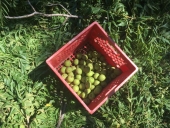I love the rituals of making and sharing drinks: tea, coffee, cocktails, sodas, cider, beer, fresh juices, kombucha, chai... so many recipes, and such a fun side of the kitchen! Since the new year these have all been non-alcoholic for me, though not necessarily so for guests. The change has come with enough of a bonus that I want to keep it going a little longer, however; one thing i have realized i am missing is the end-of-the-day pain relief function of an alcoholic drink. This is tricky territory! There has to be at least some mild pain relieving ingredient/function, but it’s really the psycho-somatic “feeling good again” anticipation caused by the ritual that I’m after. Much like how the sugary coating of an Advil sometimes makes you feel instantly better. Incidentally, super spicy food has this function for me as well.
I’d like to hear about your drink-centric end-of-the-day recipes or rituals that help you get over it all. Bonus, if it helps you deal with the combination of aging and a physically demanding life!
Cheers!






